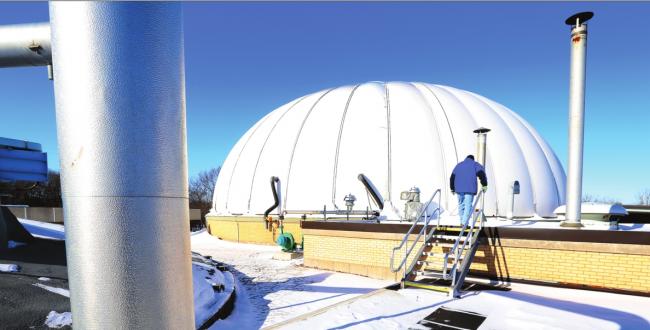
Wastewater utility generates electricity and makes money
JANESVILLE
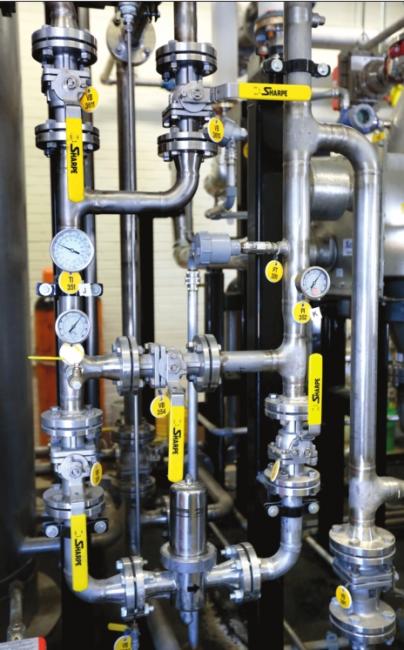 Look, it’s an electric company.
Look, it’s an electric company.
It’s a fuel producer and fertilizer plant.
No, it’s Super Plant. Janesville’s wastewater utility does it all, even as it is fulfilling its primary goal of treating the city’s waste.
The utility uses the methane gas it produces—a byproduct of wastewater treatment—to create electricity, fuel and heat. In 2013, for example, Alliant bought $188,348 in electricity from the utility.
How does it work? The solids collected in the treatment process are pumped to the digesters. Methane is a byproduct of anaerobic digestion, in which microorganisms, basically bugs, eat biodegradable material. The methane produced flows to the generator building, where its energy spins turbines at 65,000 revolutions per minute, almost as fast as jet engines, said David Botts, utility director.
The turbines produce electricity and heat.
The kilowatts produced are sold to Alliant at peak rates.
On a recent morning, the utility was producing 302 kilowatts of electricity, which is sold for about 12 cents a kilowatt during peak hours and 7.28 cents off peak.
The utility also collects the heat produced from the turbines and uses it to heat the water in the digester and lower the facility’s use of natural gas. Excess heat is used to heat the facility itself.
The methane is also turned into compressed natural gas to fuel vehicles. The utility must remove enough carbon dioxide, another byproduct of the anaerobic digester, so the fuel is 91 percent methane, which is the standard for vehicle fuel. The utility fuels four vehicles and a lawn mower with CNG.
The utility has created electricity from methane gas since the 1930s. At one point, it also experimented with fuel derived from methane to power vehicles, but the technology wasn’t mature.
As part of a $32-million revamp of the utility in 2010, the city installed microturbines to replace methanepowered internal-combustion engines it had used to generate electricity.
 The upgrade also allowed the utility to accept highly concentrated waste—such as byproducts from the production of ethanol, cheese and other food production—to raise $146,000 in revenue annually.
The upgrade also allowed the utility to accept highly concentrated waste—such as byproducts from the production of ethanol, cheese and other food production—to raise $146,000 in revenue annually.
The utility charges waste haulers to accept the high-strength waste, so it makes money there, as well.
In 2011, then-Director Dan Lynch asked and the council approved spending $750,000 to upgrade equipment at the wastewater treatment plant to create CNG.
At the time, Lynch said staff had no idea how efficient the new microturbines would be.
He predicted the additional equipment would allow the utility to at least double its production of electricity, create natural gas to fuel city vehicles and accept highly concentrated industrial waste.
Lynch, who retired at the end of 2011, estimated then the investment could return more than $3.5 million to the city in the next decade.
At the time, the utility was earning $180,000 annually in electricity. That amount has not increased appreciably, however, and Lynch said that could be because the utility isn’t processing as much highly concentrated waste as he had projected.
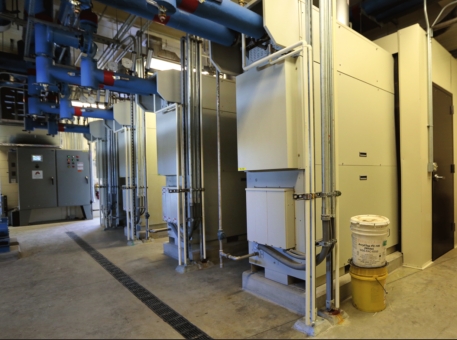 Dave Botts, the current utility director, agreed the estimates Lynch used were based on receiving a large volume of high-strength waste.
Dave Botts, the current utility director, agreed the estimates Lynch used were based on receiving a large volume of high-strength waste.
“I believe he had a vendor in mind for that product, but it did not last very long,” Botts said.
“We are working with several companies to bring us high-strength waste, but it has not been as often as we would like,” Botts said.
Still, he said the system would operate more efficiently this year and produce more electricity.
“I believe 2014 will be a better year for electricity generation because we have the new components well-tuned with the addition of the new heat exchanger,” Botts said.
Botts thinks the market for CNG will eventually improve, as well.
CNG burns cleaner than gasoline and is renewable.
“We make it everyday,” Botts said.
The utility hasn’t converted more than the five vehicles because conversion kits are expensive. Botts figures the kits will come down in price and make the payback period feasible. Right now, the payback is about 15 years, and the city keeps its vehicles for 10 to 12 years, he said.
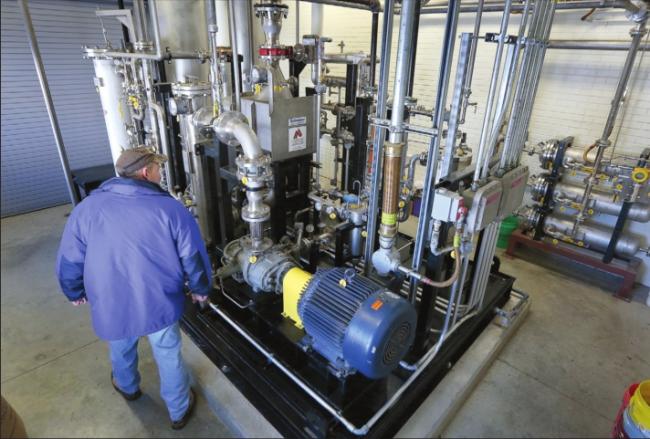 Botts said Frito-Lay is converting its entire trucking fleet to CNG.
Botts said Frito-Lay is converting its entire trucking fleet to CNG.
“Once that type of fuel becomes more common, the cost of the conversion kits will go down, and (the city will) start adding more to our fleet,” Botts said.
The sludge byproduct that remains after water is treated is used to fertilize farm fields.
Bill Olmsted/[email protected] A complex series of pipes and machinery at the wastewater treatment plant refines raw methane into a gas that the city of Janesville uses for power and vehicle fuel.
After the sludge sits in the digester for 25 days, the water is spun out, and the sludge is stored in trailers. It is applied on farmers’ fields free of charge in spring and fall. The utility recently built additional storage to hold the sludge through winter.
The utility also uses water and solar energy to lower its facility energy costs.
The wastewater facility has incorporated more green features than any other city facility, said Jay Winzenz, director of administrative services.
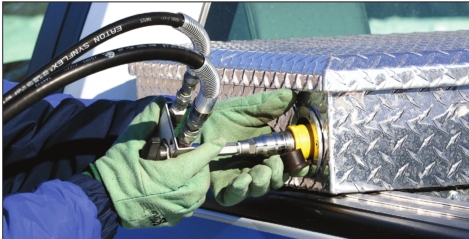 Its main administrative building uses some of the effluent—the water discharged into the river that stays at a temperature of about 50 to 60 degrees—for heating and cooling.
Its main administrative building uses some of the effluent—the water discharged into the river that stays at a temperature of about 50 to 60 degrees—for heating and cooling.
Solar panels on the southfacing slope of the building also produce electricity that is sold back to Alliant at 9 cents a kilowatt.
The technology has been evolving through the years, Botts said.
“Who knows what it’s going to look like in five more years?” he said.
The utility doesn’t produce enough energy to offset the entire cost to the plant, but being “cost neutral,” is always a goal.
Botts doubts, though, whether the utility could ever get that efficient because energy costs at the utility are so high.
He hopes the utility could eventually cut its costs by a quarter to a third.